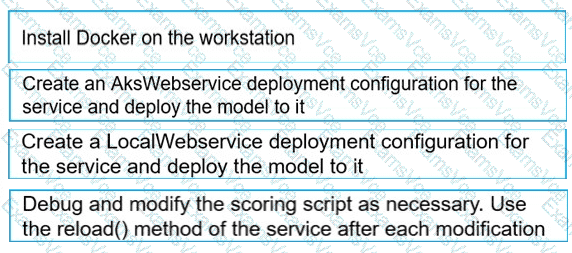
Step 1: Install Docker on the workstation
Prerequisites include having a working Docker installation on your local system.
Build or download the dockerfile to the compute node.
Step 2: Create an AksWebservice deployment configuration and deploy the model to it
To deploy a model to Azure Kubernetes Service, create a deployment configuration that describes the compute resources needed.
# If deploying to a cluster configured for dev/test, ensure that it was created with enough
# cores and memory to handle this deployment configuration. Note that memory is also used by
# things such as dependencies and AML components.
deployment_config = AksWebservice.deploy_configuration(cpu_cores = 1, memory_gb = 1)
service = Model.deploy(ws, "myservice", [model], inference_config, deployment_config, aks_target)
service.wait_for_deployment(show_output = True)
print(service.state)
print(service.get_logs())
Step 3: Create a LocalWebservice deployment configuration for the service and deploy the model to it
To deploy locally, modify your code to use LocalWebservice.deploy_configuration() to create a deployment configuration. Then use Model.deploy() to deploy the service.
Step 4: Debug and modify the scoring script as necessary. Use the reload() method of the service after each modification.
During local testing, you may need to update the score.py file to add logging or attempt to resolve any problems that you've discovered. To reload changes to the score.py file, use reload(). For example, the following code reloads the script for the service, and then sends data to it.
[Reference:, https://docs.microsoft.com/en-us/azure/machine-learning/how-to-deploy-azure-kubernetes-service, , https://docs.microsoft.com/en-us/azure/machine-learning/how-to-troubleshoot-deployment-local, , , , , , ]






